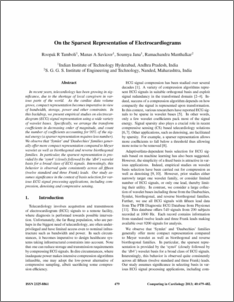Tamboli, R R and Savkoor, M A and Jana, Soumya and Manthalkar, R
(2013)
On the Sparsest Representation of Electrocardiograms.
In: 40th Computing in Cardiology Conference, CinC, 22-25, September 2013, Zaragoza; Spain.
![[img]](http://raiithold.iith.ac.in/style/images/fileicons/text.png)  Preview |
|
Text
1332_IEEE_Comp-Cardi_2013_40_479-482.pdf
- Published Version
Download (551kB)
|
Abstract
In recent years, telecardiology has been growing in significance, due to the shortage of local caregivers in various parts of the world. As the cardiac data volume grows, compact representation becomes imperative in view of bandwidth, storage, power and other constraints. In this backdrop, we present empirical studies on electrocardiogram (ECG) signal representation using a wide variety of wavelet bases. Specifically, we arrange the transform coefficients in decreasing order of magnitude, and count the number of coefficients accounting for 99% of the signal energy (a sparser representation requires less number). We observe that 'Symlet' and 'Daubechies' families generally offer more compact representation compared to Meyer wavelet as well as biorthogonal and reverse biorthogonal families. In particular, the sparsest representation is provided by the 'sym4' (closely followed by the 'db4') wavelet basis for a broad class of ECG signals. Interestingly, this behavior is observed quite consistently across all fifteen (twelve standard and three Frank) leads. Our study assumes significance in the context of basis selection for various ECG signal processing applications, including compression, denoising and compressive sensing
Actions (login required)
 |
View Item |


 Altmetric
Altmetric Altmetric
Altmetric